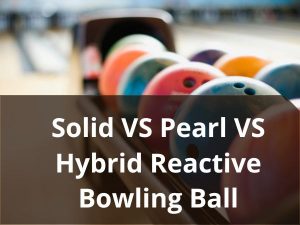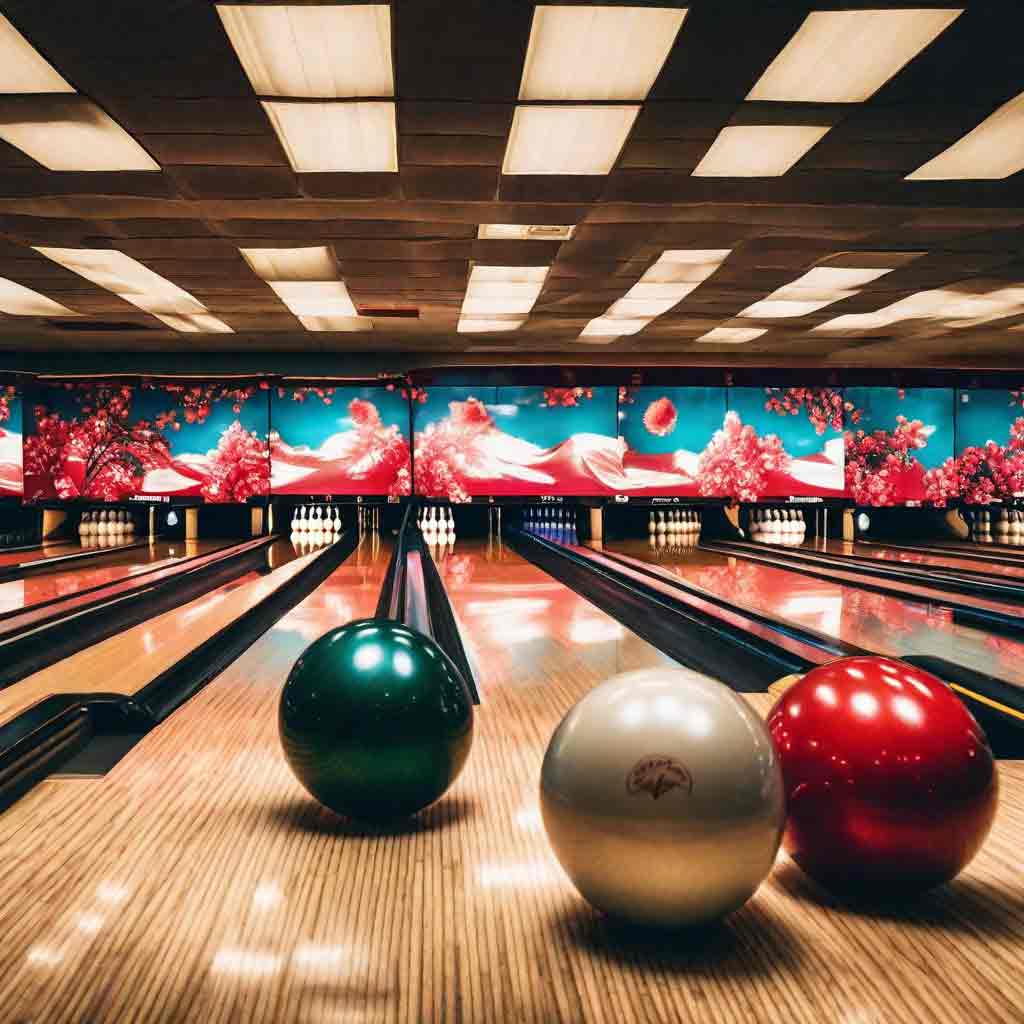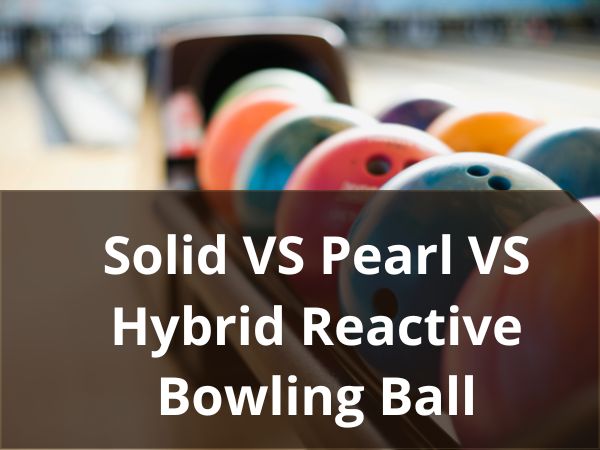Solid Vs Pearl Vs Hybrid Reactive Bowling Ball! Finding the best-quality bowling ball is essential for every bowler. No matter how well-skilled you are, you can’t prove that without the right piece of equipment. But how do you know which is the right fit for you? If you’re planning to buy a reactive bowling ball, there are a lot of things you should learn.
So solid reactive vs pearl reactive vs hybrid reactive bowling ball— which one do you think you will choose? Let me lay out the differences between these three types of bowling and define how each has its own unique characteristics. So, let’s get to know more about reactive coverstock bowling balls in depth.

Reactive Coverstock Bowling Balls
As we all know, a bowling ball is made of two primary parts — first is the exterior which is the Coverstock, and then the interior which is the Core (also known as Weight Block). Today, we will mainly focus on a particular type of coverstock and its subcategories. When a ball is thrown, the core produces the momentum at many paces, whereas the coverstock ensures smooth and controllable ball motion all the way.
Out of all the coverstocks, reactive bowling balls are by far the most popular among serious bowlers. Because your overall bowling performance depends on your ball, bowling ball with reactive covers never fail to disappoint. And, as the outer shell is in direct contact with the lane surface, the hook and flare potential is highly dependent on the type and finish of your ball’s reactive coverstock.
May bowlers claim that Reactive Resin bowling balls are less durable than Plastic and Urethane balls, but I would say otherwise. The manufacturers are constantly designing and redesigning their bowling balls. Most bowlers love it for its exceptional hook potential, friction, and pin action.
If you take a look at the formations of Reactive and Urethane coverstocks, you’ll see they are pretty similar to regular urethane formations. It’s just the extra additives that create the differences. In general, reactive resins are harder to control, but you will be needing one if you love to see your ball hook. Now, let’s talk about the three different types of Reactive coverstocks, shall we?
What is a Solid Reactive bowling ball?
Bowling balls that have lots of microscopic reactive pores are called solid reactives. Sold reactive bowling balls come in the polished or sanded finish, and buffed finish is done with a rubbing compound. Out of the factory, solid reactive bowling balls come in matte finishes. You can customize the surface finish as per your choice. These solid balls are great choices if you’re planning to bowl in medium-heavy or heavy oil lane conditions.
Out of all the reactive balls, Reactive Solid is the holy grail for most bowlers. Reactive solids are known for their top-notch early reaction and immediate lane reading ability. Bowlers reach out to Reactive solids all the time because of the control they have over the ball’s movement and reaction. If you want your bowling ball to have adequate hook potential, a piece of Solid Reactive ball will make a nice investment.
Although reactive solid bowling balls are mainly recommended on medium-heavy to heavy oil patterns, the surface of the ball absorbs the lane conditioner/oil a little fast. This happens because these solid bowling balls cut through the oil, and when it does that, the reactive microscopic pores pick up the oil from the lane. After playing for a while, be ready to see the lane getting dry.
What is a Pearl Reactive bowling ball?
Next, we have the pearl bowling balls that have the mica component blended into the formulation. This material also adds a pearly look to the coverstock of pearl reactive balls. As a matter of course, this reduces the microscopic holes on the pearl reactive coverstock and prevents the oil from the lane to get absorbed in the ball.
For tremendous lengths and the non-stop smooth ball motion, pearl reactive bowling balls are the best. This is the kind of ball every competitive bowler should have in their arsenal. Like a solid ball, Reactive pearl also reacts to the bowling lane on time. As a result, you end up with some badass high-friction backend motions.
Bowlers love to use the extended length using a pearl reactive bowling ball and then make it hook with an aggressive curve before the ball reaches the pocket. For the best trajectory, the right amount of hook, proper pin reaction, and beautiful breakpoint motion, dry lanes are perfect for pearl reactive bowling balls.

What is a Hybrid Reactive bowling ball?
You can tell by the name ‘Hybrid’ has a combination of materials from pearl and solid reactive covers. So do you get advantages of both kinds of bowling balls? Yes, why not? These hybrid bowling balls deliver mid-lane traction that no other ball can. It also provides the benefit of a controllable backend reaction, sort of the same you see in a pearl reactive coverstock.
What bowlers love about hybrid bowling balls is that they are compatible with various styles of bowling. The versatility these balls offer on the lane is jaw-dropping. The only con Hybrids have is that they are hard to control. But once you will learn to do that, you won’t be able to play with anything other than a good piece of hybrid. When Hybrids first entered the market, people were skeptical. But, now, they have earned the place they deserve as the best-selling bowling balls.
Yes, hybrids are a bit wild. But nothing an experienced bowler can’t tame. Once you learn to manage your ball’s aggressiveness, I’m confident you will love hybrid bowling balls the most. A good number of professional bowlers swear by hybrid bowling balls without any second thought. So when it comes to choosing a reactive hybrid bowling ball, do know you’re making no mistake.
Difference Between Solid Reactive, Pearl Reactive, and Hybrid Reactive Bowling Balls:
Here’s a comparison table between solid reactive, pearl reactive, and hybrid reactive bowling balls:
| Feature | Solid Reactive | Pearl Reactive | Hybrid Reactive |
|---|---|---|---|
| Surface Texture | Rough and Aggressive | Smooth and Shiny | Combination of Both |
| Ball Motion | Strong Hook Potential | Length and Backend Hook | Versatile Hook Potential |
| Oil Absorption | High | Medium | Moderate |
| Lane Condition Suitability | Heavy Oil Conditions | Medium to Light Oil | Medium to Heavy Oil |
| Ball Control | More Control | Moderate Control | Balanced Control |
| Rev Rate Tendency | Higher Rev Rate | Moderate Rev Rate | Balanced Rev Rate |
| Ball Reaction | Strong and Continuous | Angular and Snappy | Smooth and Arcing |
| Pin Carry | Medium to High | High | Balanced |
| Overall Versatility | Limited to Heavy Oil | Versatile | Versatile |
| Recommended Skill Level | Intermediate to Expert | Beginner to Expert | Intermediate to Expert |
| Price Range | High | Medium | Medium to High |
Please note that these characteristics can vary across different bowling ball models, brands, and specific compositions. It’s always recommended to consult with a bowling professional or research specific ball models for more accurate information.
Each reactive bowling has some special characteristics that make it unique and attractive to some specific bowlers. As you can tell from the I depth description, some reactive bowling balls adds extra traction and a defined backend reaction, whereas some balls are a bit more sensitive to the lane condition than other. Each has its own ball motion and reaction capabilities. The hook-ability also varies from ball to ball.
In terms of durability, reactive balls are actually less durable than urethane. But that doesn’t mean best-quality reactive bowling balls won’t last very long. I have plenty of reactive solids and reactive pearls that I own since 2012 and they are still going strong.
Compared to reactive hybrid balls and pearl balls, solids are a little more high-maintenance. So you need to clean and detox a solid ball more often. If solids are properly taken care of, they will last you for a long time.
If you’re looking for a ball that doesn’t absorb too much oil, pearl reactives are the ones you should opt for. Solid bowling balls tend to pick up a bit too much oil than others. Hybrid bowling balls fall somewhere in between these two.
Now, let’s differentiate these reactive bowling balls based on their performance. Compared to the other two reactive balls, solids deliver the most smoothest breakpoint. The angularity of a pear ball is a bit more aggressive. But which balls have the most aggressiveness? Well, Hybrids win here!
No reactive bowling balls are bad at making themselves hook at the breakpoint. But who wins this round? Well, solid balls have plenty of hooking potential. But I would say, pearls and hybrids tend to have a higher hooking potential.
Out of all the three Reactive coverstock balls, Solid Reactive bowling balls react to the lane the earliest. But this might be a problem for some bowlers. They can go for pearls or hybrids for that.
Unlike the other two bowling balls, Pearl Reactive balls go the longest. Meaning— if you are bowling straight and need lots of lengths to work with, you can’t go wrong with a pearl reactive bowling ball. The pearls will also work great if you are a low rev rate player. You will definitely enjoy the natural length pearls provide that no one else can.
Overall, all Reactive Resin bowling balls are versatile for advanced or intermediate bowlers who love to hook their balls. Hybrid bowling balls are the most versatile. So if you are a tweener-style bowler, you will immediately fall in love with the versatility hybrid bowling balls offer.
FAQs Of Solid Vs Pearl Vs Hybrid Reactive Bowling Ball!
What is the main difference between solid, pearl, and hybrid reactive bowling balls?
- Solid Reactive Balls have a matte finish, offering more friction on the lane. They’re best for heavy oil conditions as they provide a strong and early hook.
- Pearl Reactive Balls feature a shiny finish, allowing them to slide further down the lane before hooking. They perform well in medium to light oil conditions, offering a sharper backend reaction.
- Hybrid Reactive Balls combine elements of both solid and pearl reactive coverstocks. They aim to offer a middle ground, providing versatility with a smoother reaction than pearl balls and more length than solid balls.
Which type of reactive ball should a beginner choose?
Beginners often benefit from starting with a solid reactive ball due to its predictable hook and easier control in a variety of lane conditions. However, the best choice can also depend on the bowler’s style and the oil conditions they commonly face.
Can weather or temperature affect the performance of these bowling balls?
Yes, temperature and humidity can affect bowling ball performance. Cold temperatures can make reactive balls harder and less responsive, while high humidity can affect the oil pattern on the lane, indirectly influencing ball reaction.
How often should I clean my reactive bowling ball?
It’s recommended to clean your bowling ball after every session to remove oil and dirt from the surface. Deep cleaning or resurfacing might be required periodically, depending on how frequently the ball is used and the conditions it’s exposed to.
Is there a significant price difference between solid, pearl, and hybrid reactive balls?
The price of bowling balls can vary based on brand, technology, and performance features rather than the type of reactive coverstock alone. However, specialty high-performance balls in any category (solid, pearl, or hybrid) can be more expensive.
Conclusion
So, there you go, my favorite bowlers! I don’t think having a reactive resin bowling ball will feel like a waste of money. It’s going to be worth every penny! Here, I have explained every reactive resin coverstock type and its unique performance as a bowling ball. The differences between Solid Reactive vs Pearl Reactive vs Hybrid Reactive Bowling Balls. Planning to get a new bowling ball? Make sure you have a clear idea beforehand. Good Luck and never stop bowling!

Passionate Bowler and Bowling Enthusiast
Jess Pinelli is a dedicated bowling enthusiast with a deep love for the sport that spans over 6 years. With numerous strikes, spares, and a few gutter balls under hes belt, he has honed his skills on lanes across the country. Pinelli’s journey in the world of bowling has been a remarkable one, from casual weekend games with friends to competitive league play and even a few local tournaments.
Driven by her passion for the game, Pinelli decided to channel her expertise and knowledge into the digital realm, becoming a prolific author on this bowling website. She’s your go-to source for everything bowling-related, from mastering the perfect hook to choosing the right bowling ball and even navigating the world of bowling etiquette.
When she’s not busy writing informative articles or reviewing the latest bowling gear, you’ll likely find Pinellis at her favorite local bowling alley, helping newcomers improve their game or enjoying some friendly competition with fellow bowlers. She firmly believes that bowling is not just a game but a community, and she’s committed to fostering that sense of camaraderie both online and offline.




